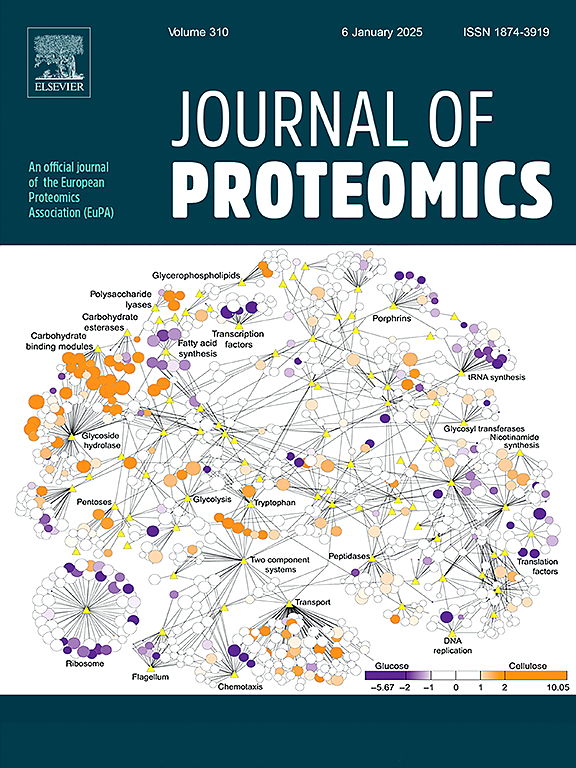比较蛋白质组学和磷蛋白质组学分析揭示了地中海水牛精液中精子活力的差异。
IF 2.8
2区 生物学
Q2 BIOCHEMICAL RESEARCH METHODS
引用次数: 0
摘要
高活力精子是哺乳动物精液低温保存和人工授精的理想精子。本研究采用定量蛋白质组学和磷酸化蛋白质组学技术对地中海水牛正常运动(NM)和低运动(LM)精子进行比较,筛选与精子运动相关的重要蛋白和磷酸化蛋白,并鉴定与地中海水牛精液质量相关的候选蛋白分子标记。蛋白质组学结果发现,与NM精子相比,LM精子中有2550个蛋白,其中119个蛋白上调,146个蛋白下调。差异丰富的蛋白质主要参与碳水化合物代谢、糖酵解/糖异生和三羧酸循环。磷酸化蛋白质组学分析显示412个蛋白,1228个磷酸化肽和1465个磷酸化修饰位点。与NM组相比,LM组白质中下调119个肽段,对应98个蛋白,上调84个磷酸化肽段,对应61个蛋白。差异磷酸化蛋白主要参与精子发生、鞭毛精子运动和糖酵解/糖异生。结合蛋白质组学和磷酸化蛋白质组学,鉴定出地中海水牛精子中常见的HMGB4、POC1B、PKM、LDHA、TBC1D21和CBY2等蛋白,这些蛋白的主要作用与精子发生、精子鞭毛结构和能量代谢有关,可作为地中海水牛精子质量的潜在标记物。本文章由计算机程序翻译,如有差异,请以英文原文为准。

Comparative proteomics and phosphoproteomics analysis reveals differential sperm motility in Mediterranean buffalo semen
High motility spermatozoa are good for cryopreservation and artificial insemination (AI) of mammalian semen. In this study, normal motility (NM) and low motility (LM) Mediterranean buffalo spermatozoa were compared using quantitative proteomics and phosphoproteomics techniques to screen for important proteins and phosphorylated proteins related to the motility of spermatozoa and to identify candidate protein molecular markers related to the quality of Mediterranean buffalo semen. Proteomics results identified 2550 proteins, with 119 proteins upregulated and 146 proteins downregulated in the LM spermatozoa versus the NM spermatozoa. The differentially abundant proteins were mainly involved in carbohydrate metabolism, glycolysis/gluconeogenesis, and tricarboxylic acid cycles. The phosphoproteomics analysis revealed 412 proteins, 1228 phosphorylated peptides, and 1465 phosphorylation modification sites. Compared to the NM group, 119 peptides were downregulated in the LM group, corresponding to 98 proteins, and 84 phosphorylated peptides were upregulated in the white matter, corresponding to 61 proteins. Differentially phosphorylated proteins were primarily involved in spermatogenesis, flagellate sperm motility, and glycolysis/gluconeogenesis. The combined proteomics and phosphoproteomics results identified the common proteins HMGB4, POC1B, PKM, LDHA, TBC1D21, and CBY2, whose main roles were related to spermatogenesis, sperm flagellar structure, and energy metabolism, which can be used as potential markers of Mediterranean buffalo sperm quality.
求助全文
通过发布文献求助,成功后即可免费获取论文全文。
去求助
来源期刊

Journal of proteomics
生物-生化研究方法
CiteScore
7.10
自引率
3.00%
发文量
227
审稿时长
73 days
期刊介绍:
Journal of Proteomics is aimed at protein scientists and analytical chemists in the field of proteomics, biomarker discovery, protein analytics, plant proteomics, microbial and animal proteomics, human studies, tissue imaging by mass spectrometry, non-conventional and non-model organism proteomics, and protein bioinformatics. The journal welcomes papers in new and upcoming areas such as metabolomics, genomics, systems biology, toxicogenomics, pharmacoproteomics.
Journal of Proteomics unifies both fundamental scientists and clinicians, and includes translational research. Suggestions for reviews, webinars and thematic issues are welcome.
 求助内容:
求助内容: 应助结果提醒方式:
应助结果提醒方式:


